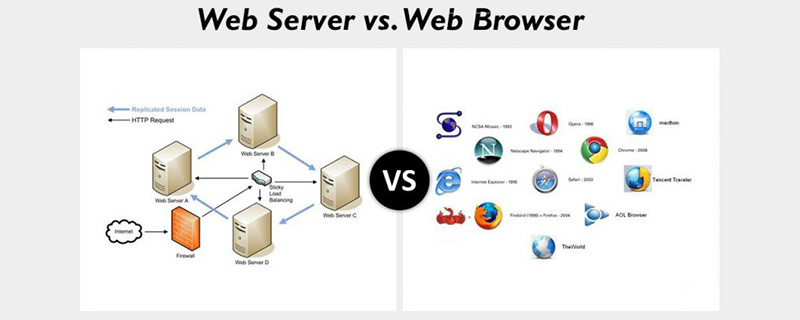 Operation and Maintenance
Operation and Maintenance
 Windows Operation and Maintenance
Windows Operation and Maintenance
 What is the difference between a web browser and a web server
What is the difference between a web browser and a web server
What is the difference between a web browser and a web server
The main difference between a web browser and a web server is that a web browser sends an HTTP request and gets an HTTP response; whereas, a web server gets an HTTP request and generates a response. Let's briefly compare web browsers and web servers and introduce the differences between them.

What is a web browser?
Web browser can be considered as an application software used by clients to access Web services and documents from the server. It acts as an interface between the server and the client. Its basic The job is to display web documents, allowing us to view and browse documents on the Internet.
There are many kinds of web browsers, such as: internet explorer, Google Chrome, Firefox, etc.

What is a web server? ?
A web server is a piece of software that runs on a computer that stores and hosts web content. Its main job is to distribute web pages to users when they need them and to provide an area to store and organize website pages.

The difference between Web browser and Web server
1. Web server is used to store the website All information and data; and web browsers are used to access and locate this information and data.
2. The web browser sends an HTTP request, obtains an HTTP response, and displays the web document to the client. It acts as the interface between the client and the server that displays web content. The web server gets the HTTP request, generates a response, and accepts client data.
3. Web browsers are used to search for content on the Internet through websites. Instead, a web server is used to establish the link between the website and the web browser.
4. The main components of the web server are server core, server core 64-bit binary files, sample applications, management command line interface, etc.; while, the component of the web browser is the user interface, UI client, layout and rendering engine, and network and data persistence parts.
Summary: The above is the entire content of this article, I hope it will be helpful to everyone's study.
The above is the detailed content of What is the difference between a web browser and a web server. For more information, please follow other related articles on the PHP Chinese website!

Hot AI Tools

Undresser.AI Undress
AI-powered app for creating realistic nude photos

AI Clothes Remover
Online AI tool for removing clothes from photos.

Undress AI Tool
Undress images for free

Clothoff.io
AI clothes remover

AI Hentai Generator
Generate AI Hentai for free.

Hot Article

Hot Tools

Notepad++7.3.1
Easy-to-use and free code editor

SublimeText3 Chinese version
Chinese version, very easy to use

Zend Studio 13.0.1
Powerful PHP integrated development environment

Dreamweaver CS6
Visual web development tools

SublimeText3 Mac version
God-level code editing software (SublimeText3)

Hot Topics
 1379
1379
 52
52
 What are the five common web servers?
Aug 25, 2022 pm 02:03 PM
What are the five common web servers?
Aug 25, 2022 pm 02:03 PM
The five types of web servers are: 1. IIS, a web server that allows publishing information on a public intranet or Internet; 2. Apache, an open source web server of the Apache Software Foundation; 3. WebSphere Application Server, a Web application server; 4. Tomcat is a Java-based Web application software container; 5. Lighttpsd is an open source Web server software.
 Security auditing and event log management of web servers built on CentOS
Aug 05, 2023 pm 02:33 PM
Security auditing and event log management of web servers built on CentOS
Aug 05, 2023 pm 02:33 PM
Overview of security auditing and event log management of web servers built on CentOS. With the development of the Internet, security auditing and event log management of web servers have become more and more important. After setting up a web server on the CentOS operating system, we need to pay attention to the security of the server and protect the server from malicious attacks. This article will introduce how to perform security auditing and event log management, and provide relevant code examples. Security audit Security audit refers to comprehensive monitoring and inspection of the security status of the server to promptly discover potential
 Best Practices: Performance Tuning Guide for Building a Web Server on CentOS
Aug 04, 2023 pm 12:17 PM
Best Practices: Performance Tuning Guide for Building a Web Server on CentOS
Aug 04, 2023 pm 12:17 PM
Best Practices: Performance Tuning Guide for Building Web Servers on CentOS Summary: This article aims to provide some performance tuning best practices for users building web servers on CentOS, aiming to improve the performance and response speed of the server. Some key tuning parameters and commonly used optimization methods will be introduced, and some sample codes will be provided to help readers better understand and apply these methods. 1. Turn off unnecessary services. When building a web server on CentOS, some unnecessary services will be started by default, which will occupy system resources.
 Permissions and access control strategies that you need to pay attention to before building a web server on CentOS
Aug 05, 2023 am 11:13 AM
Permissions and access control strategies that you need to pay attention to before building a web server on CentOS
Aug 05, 2023 am 11:13 AM
Permissions and access control strategies that you need to pay attention to before building a web server on CentOS. In the process of building a web server, permissions and access control strategies are very important. Correctly setting permissions and access control policies can protect the security of the server and prevent unauthorized users from accessing sensitive data or improperly operating the server. This article will introduce the permissions and access control strategies that need to be paid attention to when building a web server under the CentOS system, and provide corresponding code examples. User and group management First, we need to create a dedicated
 Discuss why web servers don't use swoole
Mar 27, 2023 pm 03:29 PM
Discuss why web servers don't use swoole
Mar 27, 2023 pm 03:29 PM
Swoole is an open source high-performance network communication framework based on PHP. It provides the implementation of TCP/UDP server and client, as well as a variety of asynchronous IO, coroutine and other advanced features. As Swoole becomes more and more popular, many people begin to care about the use of Swoole by web servers. Why don't current web servers (such as Apache, Nginx, OpenLiteSpeed, etc.) use Swoole? Let's explore this question.
 Best practices for writing web servers in Go
Jun 18, 2023 pm 07:38 PM
Best practices for writing web servers in Go
Jun 18, 2023 pm 07:38 PM
Go language has become a popular development language, especially for network programming. When writing a web server in Go, there are many best practices to ensure the security, maintainability and scalability of the server. Here are some suggestions and practices that can help you improve the efficiency and reliability of your Go web server. Using the standard library There are many packages related to network programming in the Go language standard library. For example, the net/http package helps you write HTTP servers, and the net package helps handle low-level network connections.
 Introductory Tutorial: A quick guide to setting up a web server on CentOS
Aug 04, 2023 pm 06:04 PM
Introductory Tutorial: A quick guide to setting up a web server on CentOS
Aug 04, 2023 pm 06:04 PM
Entry-level tutorial: A quick guide to building a web server on CentOS Introduction: In today's Internet era, building your own web server has become a need for many people. This article will introduce you to how to build a web server on the CentOS operating system, and provide code examples to help readers quickly implement it. Step 1: Install and configure Apache Open the terminal and install the Apache server through the following command: sudoyuminstallhttpd After the installation is complete, start Apac
 Best practices and precautions for building a web server under CentOS 7
Aug 25, 2023 pm 11:33 PM
Best practices and precautions for building a web server under CentOS 7
Aug 25, 2023 pm 11:33 PM
Best practices and precautions for building web servers under CentOS7 Introduction: In today's Internet era, web servers are one of the core components for building and hosting websites. CentOS7 is a powerful Linux distribution widely used in server environments. This article will explore the best practices and considerations for building a web server on CentOS7, and provide some code examples to help you better understand. 1. Install Apache HTTP server Apache is the most widely used w



